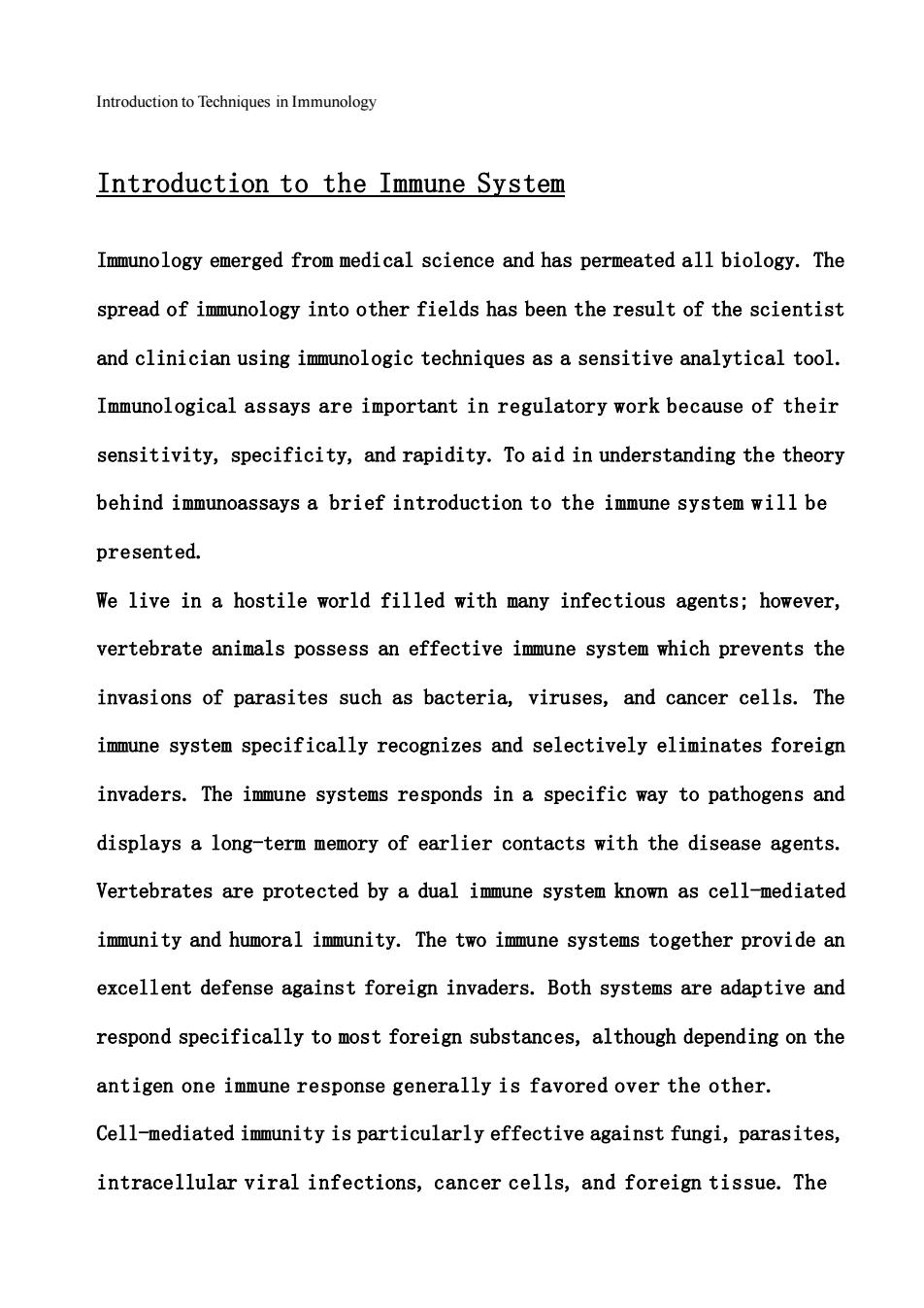
Introduction to Techniques in Immunology Introduction to the Immune System Immunology emerged from medical science and has permeated all biology.The spread of immunology into other fields has been the result of the scientist and clinician using immunologic techniques as a sensitive analytical tool. Immunological assays are important in regulatory work because of their sensitivity,specificity,and rapidity.To aid in understanding the theory behind immunoassays a brief introduction to the immune system will be presented. We live in a hostile world filled with many infectious agents;however vertebrate animals possess an effective immune system which prevents the invasions of parasites such as bacteria,viruses,and cancer cells.The immune system specifically recognizes and selectively eliminates foreign invaders.The immune systems responds in a specific way to pathogens and displays a long-term memory of earlier contacts with the disease agents. Vertebrates are protected by a dual immune system known as cell-mediated immunity and humoral immunity.The two immune systems together provide an excellent defense against foreign invaders.Both systems are adaptive and respond specificallytomost foreign substances,although depending on the antigen one immune response generally is favored over the other. Cell-mediated immunity is particularly effective against fungi,parasites intracellular viral infections,cancer cells,and foreign tissue.The
Introduction to Techniques in Immunology Introduction to the Immune System Immunology emerged from medical science and has permeated all biology. The spread of immunology into other fields has been the result of the scientist and clinician using immunologic techniques as a sensitive analytical tool. Immunological assays are important in regulatory work because of their sensitivity, specificity, and rapidity. To aid in understanding the theory behind immunoassays a brief introduction to the immune system will be presented. We live in a hostile world filled with many infectious agents; however, vertebrate animals possess an effective immune system which prevents the invasions of parasites such as bacteria, viruses, and cancer cells. The immune system specifically recognizes and selectively eliminates foreign invaders. The immune systems responds in a specific way to pathogens and displays a long-term memory of earlier contacts with the disease agents. Vertebrates are protected by a dual immune system known as cell-mediated immunity and humoral immunity. The two immune systems together provide an excellent defense against foreign invaders. Both systems are adaptive and respond specifically to most foreign substances, although depending on the antigen one immune response generally is favored over the other. Cell-mediated immunity is particularly effective against fungi, parasites, intracellular viral infections, cancer cells, and foreign tissue. The
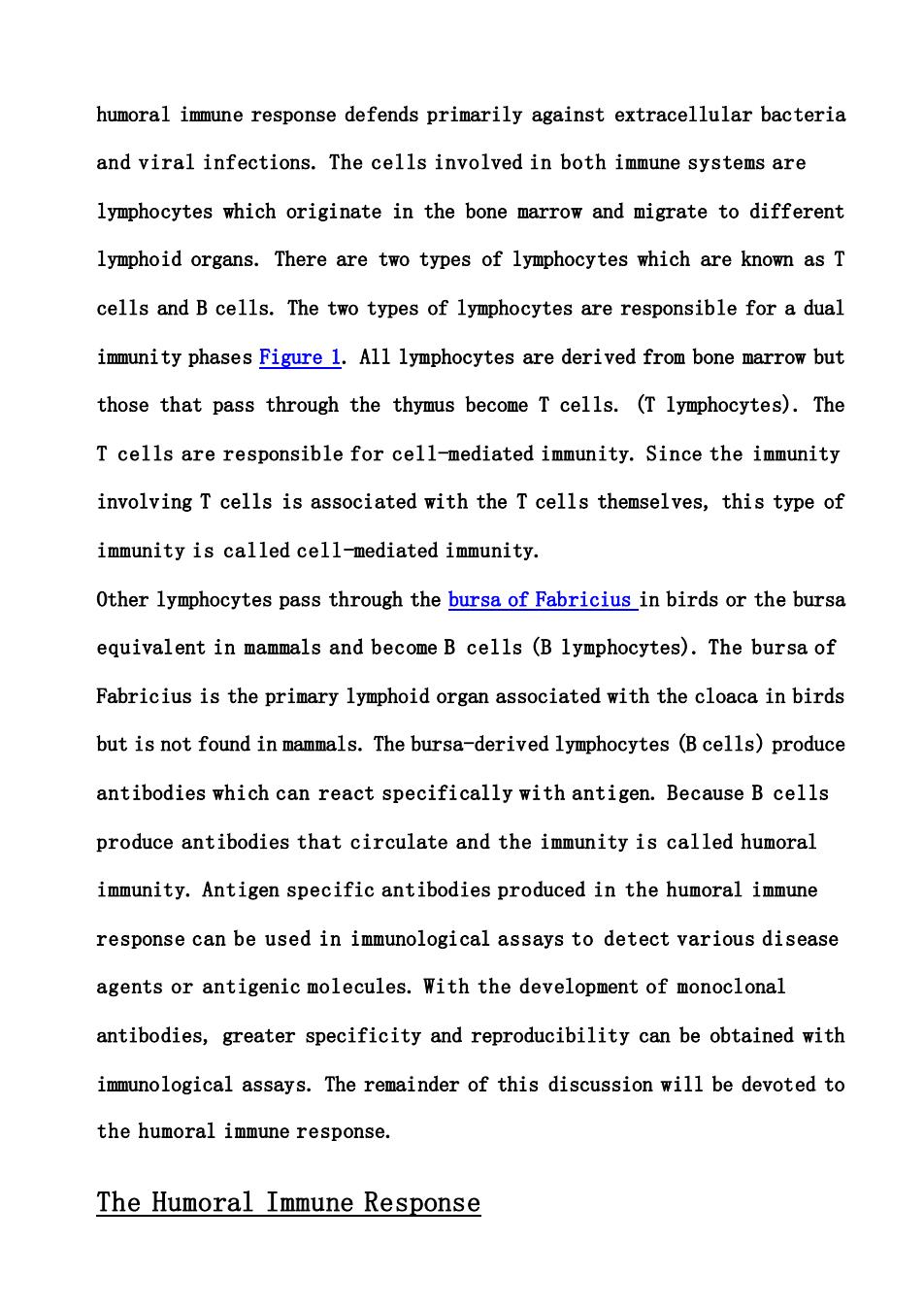
humoral immune response defends primarily against extracellular bacteria and viral infections.The cells involved in both immune systems are lymphocytes which originate in the bone marrow and migrate to different lymphoid organs.There are two types of lymphocytes which are known as T cells and B cells.The two types of lymphocytes are responsible for a dual immunity phases Figure 1.All lymphocytes are derived from bone marrow but those that pass through the thymus become T cells.(T lymphocytes).The T cells are responsible for cell-mediated immunity.Since the immunity involving T cells is associated with the T cells themselves,this type of immunity is called cell-mediated immunity. Other lymphocytes pass through the bursa of Fabricius in birds or the bursa equivalent in mammals and become B cells (B lymphocytes).The bursa of Fabricius is the primary lymphoid organ associated with the cloaca in birds but is not found in mammals.The bursa-derived lymphocytes(B cells)produce antibodies which can react specifically with antigen.Because B cells produce antibodies that circulate and the immunity is called humoral immunity.Antigen specific antibodies produced in the humoral immune response can be used in immunological assays to detect various disease agents or antigenic molecules.With the development of monoclonal antibodies,greater specificity and reproducibility can be obtained with immunological assays.The remainder of this discussion will be devoted to the humoral immune response. The Humoral Immune Response
humoral immune response defends primarily against extracellular bacteria and viral infections. The cells involved in both immune systems are lymphocytes which originate in the bone marrow and migrate to different lymphoid organs. There are two types of lymphocytes which are known as T cells and B cells. The two types of lymphocytes are responsible for a dual immunity phases Figure 1. All lymphocytes are derived from bone marrow but those that pass through the thymus become T cells. (T lymphocytes). The T cells are responsible for cell-mediated immunity. Since the immunity involving T cells is associated with the T cells themselves, this type of immunity is called cell-mediated immunity. Other lymphocytes pass through the bursa of Fabricius in birds or the bursa equivalent in mammals and become B cells (B lymphocytes). The bursa of Fabricius is the primary lymphoid organ associated with the cloaca in birds but is not found in mammals. The bursa-derived lymphocytes (B cells) produce antibodies which can react specifically with antigen. Because B cells produce antibodies that circulate and the immunity is called humoral immunity. Antigen specific antibodies produced in the humoral immune response can be used in immunological assays to detect various disease agents or antigenic molecules. With the development of monoclonal antibodies, greater specificity and reproducibility can be obtained with immunological assays. The remainder of this discussion will be devoted to the humoral immune response. The Humoral Immune Response
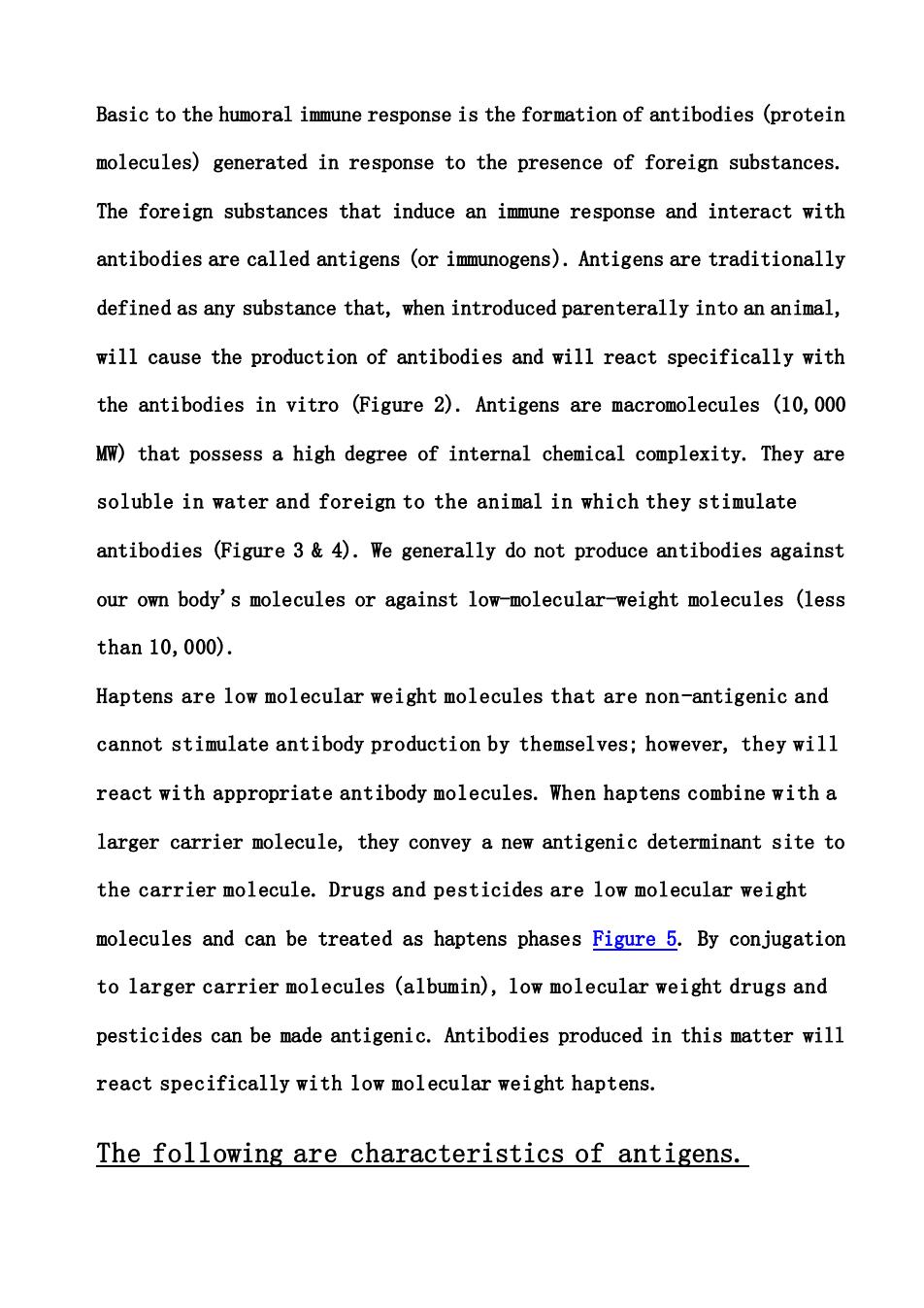
Basic to the humoral immune response is the formation of antibodies (protein molecules)generated in response to the presence of foreign substances. The foreign substances that induce an immune response and interact with antibodies are called antigens (or immunogens).Antigens are traditionally defined as any substance that,when introduced parenterally into an animal, will cause the production of antibodies and will react specifically with the antibodies in vitro (Figure 2).Antigens are macromolecules (10,000 MW)that possess a high degree of internal chemical complexity.They are soluble in water and foreign to the animal in which they stimulate antibodies (Figure 3&4).We generally do not produce antibodies against our own body's molecules or against low-molecular-weight molecules (less than 10,000). Haptens are low molecular weight molecules that are non-antigenic and cannot stimulate antibody production by themselves;however,they will react with appropriate antibody molecules.When haptens combinewitha larger carrier molecule,they convey a new antigenic determinant site to the carrier molecule.Drugs and pesticides are low molecular weight molecules and can be treated as haptens phases Figure 5.By conjugation to larger carrier molecules (albumin),low molecular weight drugs and pesticides can be made antigenic.Antibodies produced in this matter will react specifically with low molecular weight haptens. The following are characteristics of antigens
Basic to the humoral immune response is the formation of antibodies (protein molecules) generated in response to the presence of foreign substances. The foreign substances that induce an immune response and interact with antibodies are called antigens (or immunogens). Antigens are traditionally defined as any substance that, when introduced parenterally into an animal, will cause the production of antibodies and will react specifically with the antibodies in vitro (Figure 2). Antigens are macromolecules (10,000 MW) that possess a high degree of internal chemical complexity. They are soluble in water and foreign to the animal in which they stimulate antibodies (Figure 3 & 4). We generally do not produce antibodies against our own body's molecules or against low-molecular-weight molecules (less than 10,000). Haptens are low molecular weight molecules that are non-antigenic and cannot stimulate antibody production by themselves; however, they will react with appropriate antibody molecules. When haptens combine with a larger carrier molecule, they convey a new antigenic determinant site to the carrier molecule. Drugs and pesticides are low molecular weight molecules and can be treated as haptens phases Figure 5. By conjugation to larger carrier molecules (albumin), low molecular weight drugs and pesticides can be made antigenic. Antibodies produced in this matter will react specifically with low molecular weight haptens. The following are characteristics of antigens
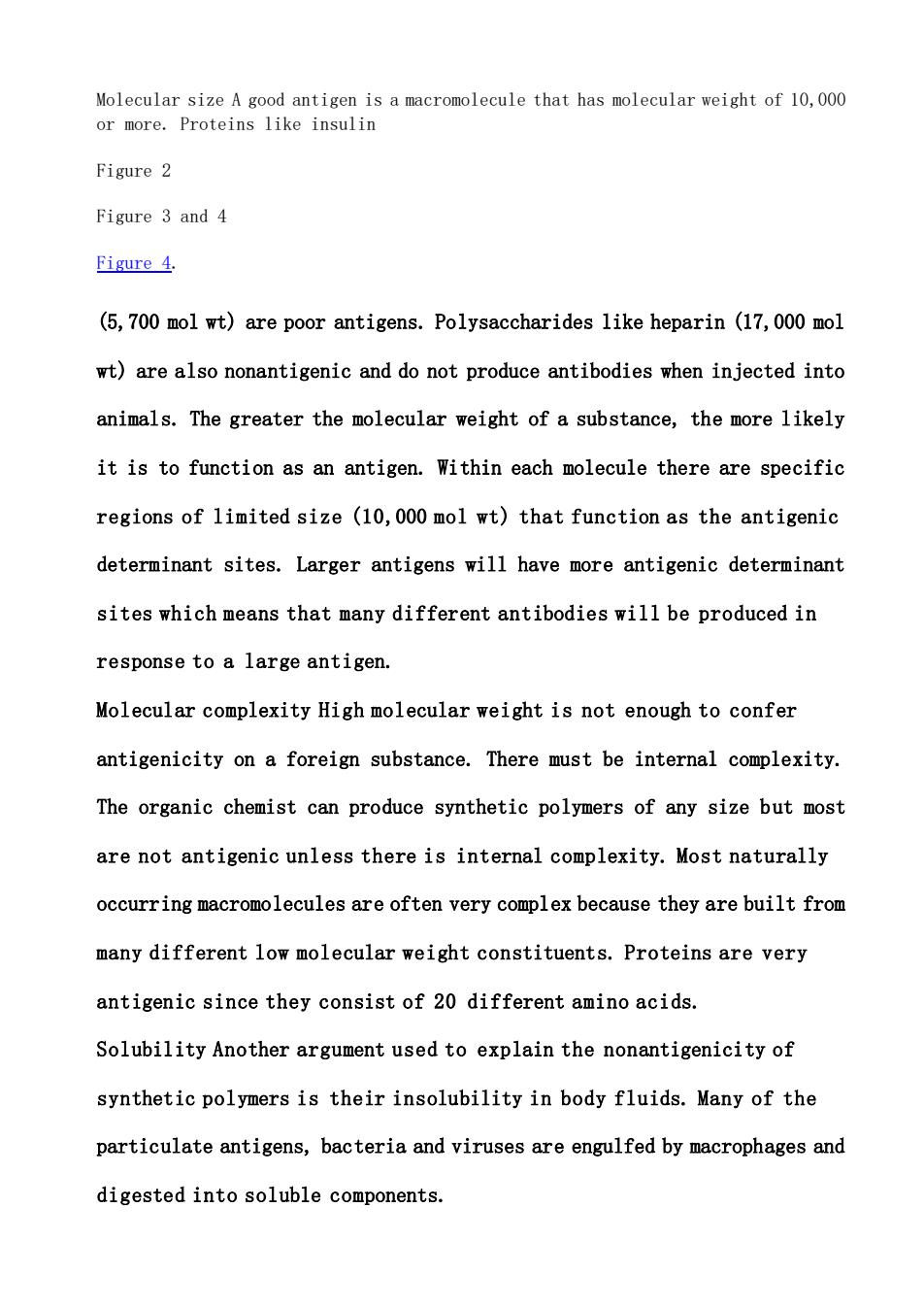
Molecular size A good antigen is a macromolecule that has molecular weight of 10,000 or more.Proteins like insulin Figure 2 Figure 3 and 4 Figure 4. (5,700 mol wt)are poor antigens.Polysaccharides like heparin (17,000 mol wt)are also nonantigenic and do not produce antibodies when injected into animals.The greater the molecular weight of a substance,the more likely it is to function as an antigen.Within each molecule there are specific regions of limited size (10,000 mol wt)that function as the antigenic determinant sites.Larger antigens will have more antigenic determinant sites which means that many different antibodies will be produced in response to a large antigen Molecular complexity High molecular weight is not enough to confer antigenicity on a foreign substance.There must be internal complexity The organic chemist can produce synthetic polymers of any size but most are not antigenic unless there is internal complexity.Most naturally occurring macromolecules are often very complex because they are built from many different low molecular weight constituents.Proteins are very antigenic since they consist of 20 different amino acids. Solubility Another argument used to explain the nonantigenicity of synthetic polymers is their insolubility in body fluids.Many of the particulate antigens,bacteria and viruses are engulfed by macrophages and digested into soluble components
Molecular size A good antigen is a macromolecule that has molecular weight of 10,000 or more. Proteins like insulin Figure 2 Figure 3 and 4 Figure 4. (5,700 mol wt) are poor antigens. Polysaccharides like heparin (17,000 mol wt) are also nonantigenic and do not produce antibodies when injected into animals. The greater the molecular weight of a substance, the more likely it is to function as an antigen. Within each molecule there are specific regions of limited size (10,000 mol wt) that function as the antigenic determinant sites. Larger antigens will have more antigenic determinant sites which means that many different antibodies will be produced in response to a large antigen. Molecular complexity High molecular weight is not enough to confer antigenicity on a foreign substance. There must be internal complexity. The organic chemist can produce synthetic polymers of any size but most are not antigenic unless there is internal complexity. Most naturally occurring macromolecules are often very complex because they are built from many different low molecular weight constituents. Proteins are very antigenic since they consist of 20 different amino acids. Solubility Another argument used to explain the nonantigenicity of synthetic polymers is their insolubility in body fluids. Many of the particulate antigens, bacteria and viruses are engulfed by macrophages and digested into soluble components
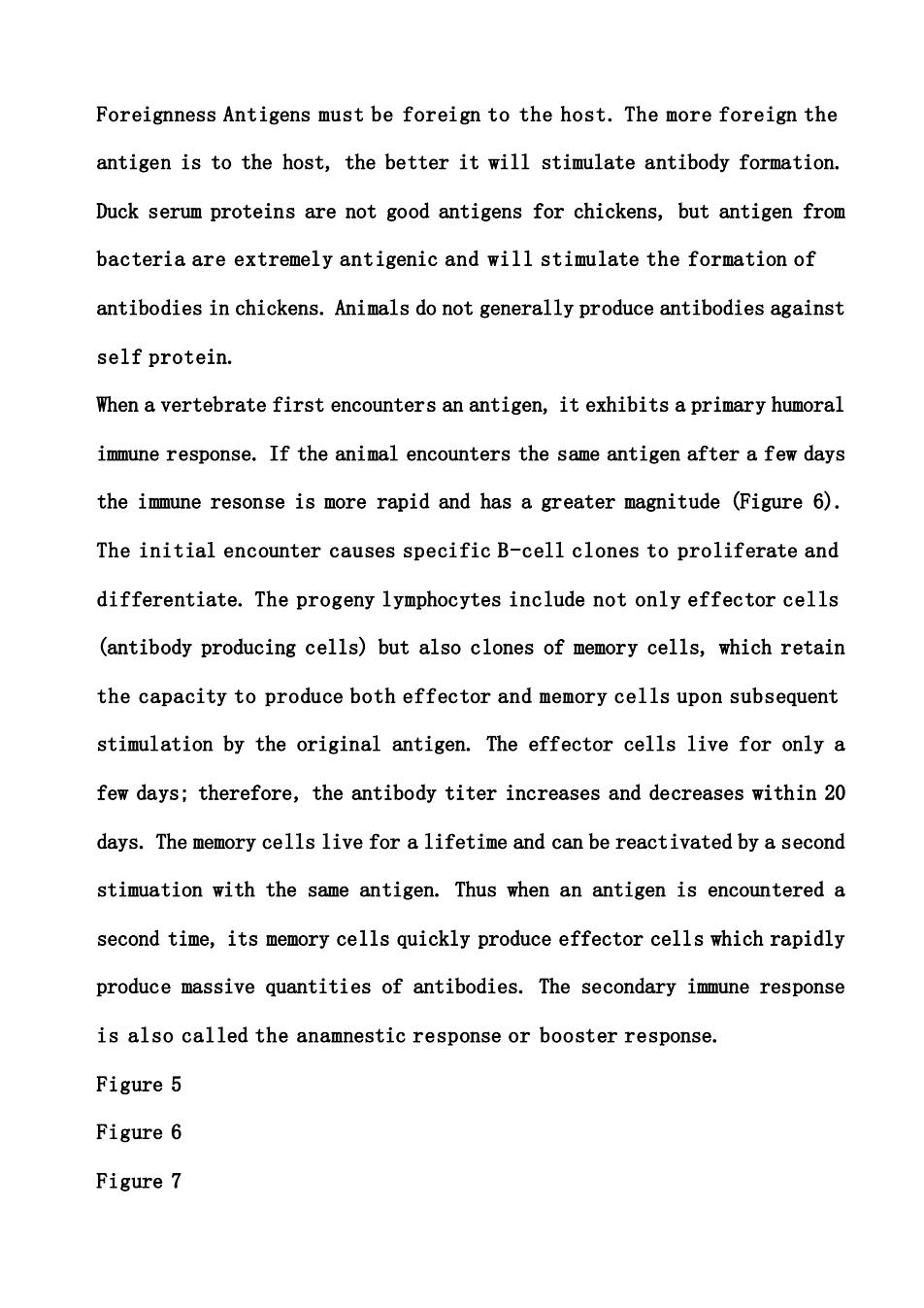
Foreignness Antigens must be foreign to the host.The more foreign the antigen is to the host,the better it will stimulate antibody formation. Duck serum proteins are not good antigens for chickens,but antigen from bacteria are extremely antigenic and will stimulate the formation of antibodies in chickens.Animals do not generally produce antibodies against self protein. When a vertebrate first encounters an antigen,it exhibits a primary humoral immune response.If the animal encounters the same antigen after a few days the immune resonse is more rapid and has a greater magnitude (Figure 6) The initial encounter causes specific B-cell clones to proliferate and differentiate.The progeny lymphocytes include not only effector cells (antibody producing cells)but also clones of memory cells,which retain the capacity to produce both effector and memory cells upon subsequent stimulation by the original antigen.The effector cells live for only a few days;therefore,the antibody titer increases and decreases within 20 days.The memory cells live for a lifetime and can be reactivated by a second stimuation with the same antigen.Thus when an antigen is encountered a second time,its memory cells quickly produce effector cells which rapidly produce massive quantities of antibodies.The secondary immune response is also called the anamnestic response or booster response. Figure 5 Figure 6 Figure 7
Foreignness Antigens must be foreign to the host. The more foreign the antigen is to the host, the better it will stimulate antibody formation. Duck serum proteins are not good antigens for chickens, but antigen from bacteria are extremely antigenic and will stimulate the formation of antibodies in chickens. Animals do not generally produce antibodies against self protein. When a vertebrate first encounters an antigen, it exhibits a primary humoral immune response. If the animal encounters the same antigen after a few days the immune resonse is more rapid and has a greater magnitude (Figure 6). The initial encounter causes specific B-cell clones to proliferate and differentiate. The progeny lymphocytes include not only effector cells (antibody producing cells) but also clones of memory cells, which retain the capacity to produce both effector and memory cells upon subsequent stimulation by the original antigen. The effector cells live for only a few days; therefore, the antibody titer increases and decreases within 20 days. The memory cells live for a lifetime and can be reactivated by a second stimuation with the same antigen. Thus when an antigen is encountered a second time, its memory cells quickly produce effector cells which rapidly produce massive quantities of antibodies. The secondary immune response is also called the anamnestic response or booster response. Figure 5 Figure 6 Figure 7